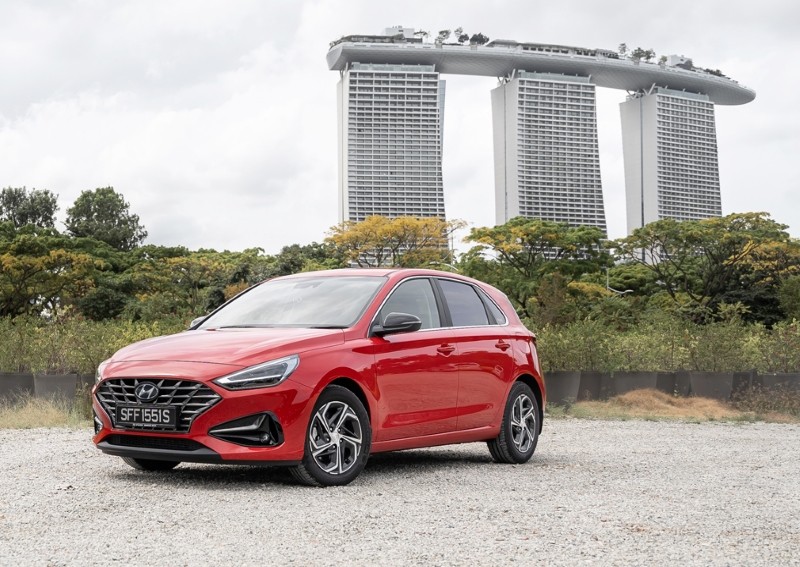Updated Hyundai i30 review: Surprisingly serene

One-litre, three-cylinder hatchbacks have a penchant for being perky and an absolute hoot to drive.
The Seat Leon and Ford Fiesta, in particular, come to mind. Models like these are supposed to be less refined than their larger-engined siblings, but in return offer greater efficiency and lower running costs.
The latest 1-litre Hyundai i30, on the other hand, seems to buck this trend, for it feels more refined than its 1.4-litre predecessor.

Changes to the i30's exterior have brought its design in line with Hyundai's newer models.
These include a larger grille, slimmer headlights, new V-shaped daytime running lights and a new rear bumper.
Hyundai's bolder styling direction might work on models like their ginormous Palisade flagship, but it is too much for this compact hatchback, which looks fine without it.
Fortunately, the designers didn't go overboard with the improvements to the interior.
The Hyundai i30's new instrument panel now features a seven-inch LCD in the middle of the cluster, surrounded by analogue gauges for the revs, temperature and fuel.
A larger eight-inch infotainment display also replaces the previous 5-inch unit, so scrolling through your Spotify playlists is now more convenient. Connectivity options, such as Apple CarPlay and USB ports, are also standard.

The biggest upgrade is the addition of SmartSense, the brand's suite of safety features that makes the i30 more secure than ever.
These include Rear Cross Traffic Collision-Avoidance Assist, Forward Collision-Avoidance Assist and Smart Cruise Control with Stop & Go, which helps reduce the driver's burden in a traffic jam.
Three-cylinder engines are known to have "thrummy" soundtracks, but the unit in the new Hyundai i30 is pretty quiet.
You barely hear it at idle, and it takes some revving to hear its vocals. I recall needing to crank it to 5000rpm to really hear it.
Speaking of revs, these are exactly what the motor needs to get the hatchback moving from a standstill. The engine can hardly be called anaemic though - not when it produces 118hp and 200Nm.
But perhaps due to inertia, the torque doesn't seem to be present when the car moves off the line. Acceleration becomes easier when the hatchback is already moving, with the powerplant feeling more tractable at moderate to expressway speeds.

Overall performance is slower compared to the previous i30. This facelifted 1-litre model does the century sprint in 11.2 seconds, two seconds slower than the older i30.
[[nid:508020]]
But to be fair, that model has a turbocharged 1.4-litre capable of 138hp and 242Nm. The difference in performance is not unreasonable.
Though the i30's size still makes it fun to hurl into corners, I found it more satisfying to drive this hatchback "normally", for it felt even more refined than before.
Cruising on expressways is a surprisingly hushed affair. Activate the adaptive cruise control and it will be a relaxing one, too. At times, I found it hard to believe that this was a 3-cylinder engine.
Instead of feeling "younger" and livelier, the latest i30's character is more mature and composed.

The i30 would suit someone who needs the flexibility of a hatchback. For instance, if cycling is your hobby, the i30's ability to accommodate a bicycle would be pretty convenient.
And if you like hatchbacks in general for their easy manoeuvrability, then the i30 is certainly likeable, especially with its long list of safety features.
But as attractive as the i30 is, it is overshadowed by an even more compelling proposition: the Avante.
Currently listed at $100,999, the i30 costs the same as the top-spec Avante Elite, which I imagine most drivers would gravitate to.

Engine: 998cc, 12-valves, inline-3, turbocharged
Max power: 118hp (120PS, 88.3kW) at 6000rpm
Max torque: 200Nm at 2000-3500rpm
Gearbox: Seven-speed dual-clutch with manual select
0-100km/h: 11.2 seconds
Top speed: 196km/h
Consumption: 18.9km/L (combined)
Price incl. COE: $103,999 (no VES rebate/surcharge)
Agent: Komoco Motors